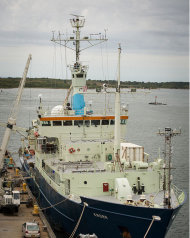Why Hurricane Season Peaks Today
By OurAmazingPlanet Staff | LiveScience.com – 4 hrs agoRELATED CONTENTA NASA satellite caught this image …
Today (Sept. 10) marks the historic peak of the Atlantic hurricane season. Sure enough, there are currently three storms churning inthe Atlantic Ocean, including Tropical Storm Leslie, Hurricane Michael and a tropical wave that is likely to become a tropical depression.
Tropical Storm Leslie is expected to hit Newfoundland midday tomorrow. While it isn't likely to regain hurricane strength, it is expected to lash the island with winds of up to 40 mph (64 kph), according to the National Oceanographic and Atmospheric Administration (NOAA).
Meanwhile, Hurricane Michael is churning away in the middle of the Atlantic with maximum sustained winds of 80 mph (130 kph). It will likely weaken into a tropical storm later today.
If the tropical wave develops into a named storm, it will be called Nadine.
Today is the peak of the season largely due to wide expanses of warm water in the Caribbean Sea and Atlantic Ocean that are favorable for hurricane formation; such waters fuel cyclones once they form. Atlantic surface temperatures are now at their warmest, after slowly heating up in the sun all summer long.
There is also currently little wind shear over the Atlantic. Wind shear is caused by differences in atmospheric pressure between neighboring regions and reduces the strength of cyclones by separating their warm core from the system of circulation above it. Cyclones are essentially large heat engines that are driven by a temperature difference between the warm ocean surface and the cool atmosphere above; wind shear disrupts this pattern of circulation and weakens storms.
Now is also an ideal time for tropical waves, which are caused by the disruption of the ocean surface by hot, dry air, often blown west from Africa's Sahara region. Tropical waves are often precursors to tropical cyclones; about 60 percent of cyclones form from tropical waves.
So far this year, there have been 13 named storms in the Atlantic, including seven hurricanes. Storms are named only once they attain tropical storm status — defined as a rotating, organized storm with maximum sustained winds of at least 39 mph (63 kph).
The season started earlier than usual, with two named storms before June 1, the traditional beginning of the hurricane season. Activity then died down in July, but has picked up in August and September, the typical peak of the season.
NOAA updated its forecast for the season in August, saying that 2012 was likely to be a busier-than-normal year. The forecast at the beginning of the season had called for a "near-normal" year.
The new forecast calls for 12 to 17 named storms, including the storms that have already occurred, of which forecasters expected five to eight to become hurricanes.
Tropical Storm Beryl made history as the strongest May storm on record to hit Florida, with sustained winds up to 70 mph (113 kph), just below the 74 mph (119 kph) cutoff for hurricanes. A few weeks later there was Tropical Storm Debby, which dumped large amounts of rain across Florida.
Hurricane Isaac has been the only hurricane to strike the United States so far this year. Isaac made landfall on the evening of Aug. 28 near the mouth of the Mississippi River as a Category 1 storm, packing winds of 80 mph (130 kph). It was a large, slow-moving storm but also a prodigious rainmaker, causing flooding throughout the South and Midwest.
- In Images: Hurricane Season 2012
- Storm Season! How, When & Where Hurricanes Form
- Hurricanes from Above: See Nature's Biggest Storms
Copyright 2012 OurAmazingPlanet, a TechMediaNetwork company. All rights reserved. This material may not be published, broadcast, rewritten or redistributed.
Tropical Storm Leslie is expected to hit Newfoundland midday tomorrow. While it isn't likely to regain hurricane strength, it is expected to lash the island with winds of up to 40 mph (64 kph), according to the National Oceanographic and Atmospheric Administration (NOAA).
Meanwhile, Hurricane Michael is churning away in the middle of the Atlantic with maximum sustained winds of 80 mph (130 kph). It will likely weaken into a tropical storm later today.
Today is the peak of the season largely due to wide expanses of warm water in the Caribbean Sea and Atlantic Ocean that are favorable for hurricane formation; such waters fuel cyclones once they form. Atlantic surface temperatures are now at their warmest, after slowly heating up in the sun all summer long.
There is also currently little wind shear over the Atlantic. Wind shear is caused by differences in atmospheric pressure between neighboring regions and reduces the strength of cyclones by separating their warm core from the system of circulation above it. Cyclones are essentially large heat engines that are driven by a temperature difference between the warm ocean surface and the cool atmosphere above; wind shear disrupts this pattern of circulation and weakens storms.
Now is also an ideal time for tropical waves, which are caused by the disruption of the ocean surface by hot, dry air, often blown west from Africa's Sahara region. Tropical waves are often precursors to tropical cyclones; about 60 percent of cyclones form from tropical waves.
The season started earlier than usual, with two named storms before June 1, the traditional beginning of the hurricane season. Activity then died down in July, but has picked up in August and September, the typical peak of the season.
NOAA updated its forecast for the season in August, saying that 2012 was likely to be a busier-than-normal year. The forecast at the beginning of the season had called for a "near-normal" year.
The new forecast calls for 12 to 17 named storms, including the storms that have already occurred, of which forecasters expected five to eight to become hurricanes.
Tropical Storm Beryl made history as the strongest May storm on record to hit Florida, with sustained winds up to 70 mph (113 kph), just below the 74 mph (119 kph) cutoff for hurricanes. A few weeks later there was Tropical Storm Debby, which dumped large amounts of rain across Florida.
Hurricane Isaac has been the only hurricane to strike the United States so far this year. Isaac made landfall on the evening of Aug. 28 near the mouth of the Mississippi River as a Category 1 storm, packing winds of 80 mph (130 kph). It was a large, slow-moving storm but also a prodigious rainmaker, causing flooding throughout the South and Midwest.
!_Mysterious Changes in Ocean Salt Spur NASA Expedition_!
By Wynne Parry, LiveScience Senior Writer | LiveScience.com – 7 hrs ago Mysterious ocean changes spur probe
Mysterious ocean changes spur probeRELATED CONTENT

The Woods Hole Oceanographic Institution's …
Over the past 50 years, the salty parts of the oceans have become saltier and the fresh regions have become fresher, and the degree of change is greater than scientists can explain.
Researchers are heading out into one particularly salty ocean region, in the middle of the North Atlantic Ocean, in the hopes of better understanding what drives variation in salinity in the upper ocean.
Ultimately, they hope, research like this will offer insight on the dynamics behind the dramatic changes in the ocean's salt content.
Many oceanographers have a hunch about what is going on: Climate change, Ray Schmitt, a senior scientist at the Woods Hole Oceanographic Institution, told journalists during a news conference Wednesday (Sept. 5).
"Climate is changing all the time, and some of that change is due to natural variation," Schmitt said. "The 50-year trend we are talking about, most of us believe is really due to the general trend of global warming."
Salt & the global water cycle
This matters because the ocean is at the heart of the planet's water cycle: 86 percent of global evaporation and 78 percent of global precipitation occur over the ocean, according to NASA, the lead entity behind the project, called Salinity Processes in the Upper Ocean Regional Study (SPURS).
Over the ocean, more evaporation as compared to precipitation translates into saltier water. Meanwhile, in regions where precipitation is favored, water is fresher.
By tracking ocean salinity, researchers can better understand the global water cycle.
Global warming is expected to intensify it, but current computer models do not predict the amount of change seen over the last 50 years, Schmitt said.
Global warming is expected to intensify it, but current computer models do not predict the amount of change seen over the last 50 years, Schmitt said.
Aside from an increase in evaporation caused by warming, such factors as winds can also contribute tochanges in salinity.
"We have a lot of questions about the basic physics we hope to resolve with this cruise," Schmitt said.
In addition to instruments attached to the research vessel itself, scientists plan to deploy a variety of drifting, remotely operated and moored sensors.
European researchers are also visiting the site and collecting data.
European researchers are also visiting the site and collecting data.
Salinity data is also expected to come from the satellite-borne instrument, called Aquarius, launched about a year ago, as well as the global network of Argo floats, which measure temperature and salinity.
[Satellite Gallery: Science from Above]
[Satellite Gallery: Science from Above]
The research vessel Knorr departed Woods Hole, Mass., for the mid-Atlantic Thursday (Sept. 6).
The researchers will spend about three weeks deploying their instruments, leaving some behind for when they return.
Due to hurricanes Leslie and Michael, the vessel's captain decided to travel quickly to the east and then south to miss the worst of the weather on their way to the study site.
The researchers will spend about three weeks deploying their instruments, leaving some behind for when they return.
Due to hurricanes Leslie and Michael, the vessel's captain decided to travel quickly to the east and then south to miss the worst of the weather on their way to the study site.
Ongoing work
The mid-Atlantic isn't the only area where researchers hope to study ocean salinity in detail.
"SPURS is named because spurs come in pairs," said Eric Lindstrom, a physical oceanography program scientist at NASA headquarters, explaining that researchers hope to do something similar in a low-salinity region, such as the Bay of Bengal or an area south of Hawaii.
While researchers think global climate change may be behind the changes in ocean salinity, changes like these are expected to have their own implications for climate.
This is because ocean salinity also affects ocean circulation, and as a result, ocean temperatures, which have implications for weather.
Here's how it works: Compared with fresh water, salty water is heavier, and so more prone to sinking.
Temperature has a similar effect, with warmth causing water to rise. Differences in salinity and temperature drive a slow-moving conveyor belt of ocean currents that encircles the planet.
The Gulf Stream, which carries warm water across the Atlantic to Europe, is part of this conveyor belt.
Temperature has a similar effect, with warmth causing water to rise. Differences in salinity and temperature drive a slow-moving conveyor belt of ocean currents that encircles the planet.
The Gulf Stream, which carries warm water across the Atlantic to Europe, is part of this conveyor belt.
It may work out that higher salinity in some regions counterbalances fresher water in others, Schmitt said:
"It is a delicate balance and what we think now is it is not too likely the conveyer belt is going to shut down anytime soon."
"It is a delicate balance and what we think now is it is not too likely the conveyer belt is going to shut down anytime soon."
Follow Wynne Parry on Twitter @Wynne_Parry or LiveScience @livescience. We're also onFacebook & Google+.
- 50 Interesting Facts About The Earth
- The Reality of Climate Change: 10 Myths Busted
- The World's Biggest Oceans and Seas
_More News_
 Kenyan cleric shot dead, sparks riots …
Kenyan cleric shot dead, sparks riots … A policeman gives orders to his officers …
A policeman gives orders to his officers … A policeman gives orders to his officers …
A policeman gives orders to his officers …U.S. drone kills five suspected militants …
 An elder tries to calm a group of youths …
An elder tries to calm a group of youths … The army and local fighters also arrested …
The army and local fighters also arrested … Yemen says kills deputy regional head …
Yemen says kills deputy regional head … Aboud Rogo Mohammed allegedly supported …
Aboud Rogo Mohammed allegedly supported …

No comments:
Post a Comment
Note: Only a member of this blog may post a comment.